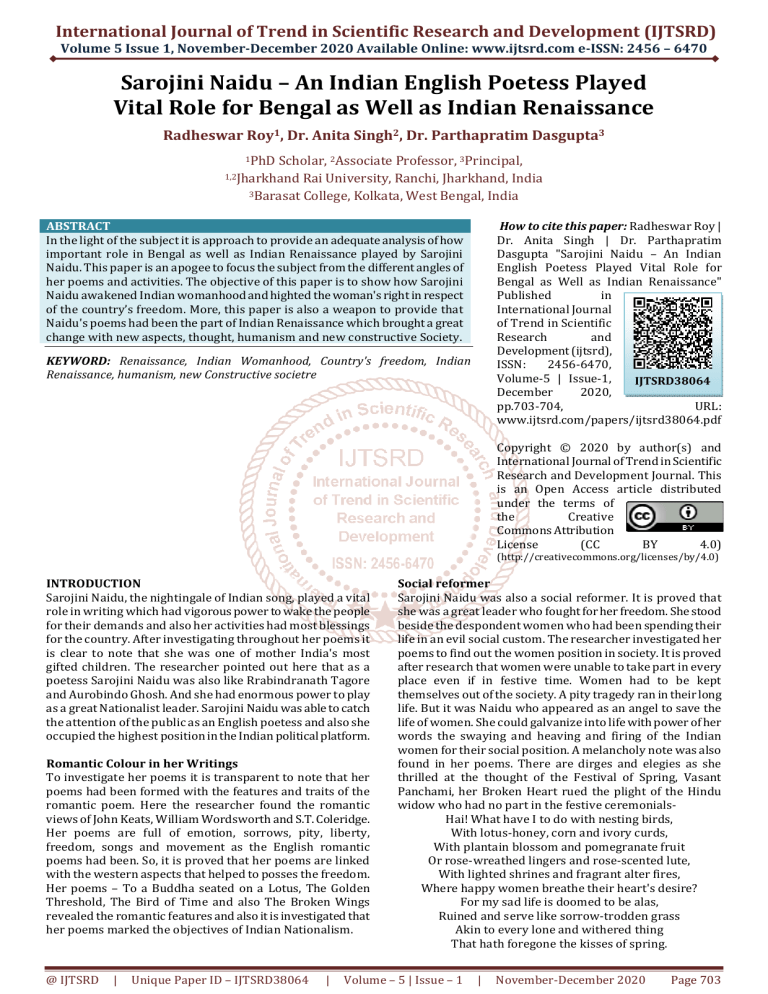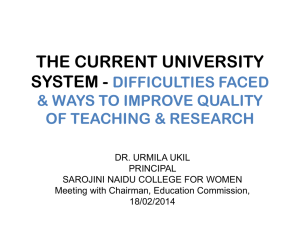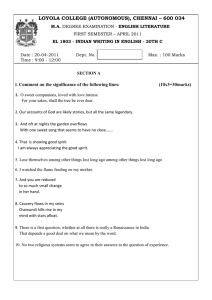
International Journal of Trend in Scientific Research and Development (IJTSRD)
Volume 5 Issue 1, November-December 2020 Available Online: www.ijtsrd.com e-ISSN: 2456 – 6470
Sarojini Naidu – An Indian English Poetess Played
Vital Role for Bengal as Well as Indian Renaissance
Radheswar Roy1, Dr. Anita Singh2, Dr. Parthapratim Dasgupta3
1PhD
Scholar, 2Associate Professor, 3Principal,
1,2Jharkhand Rai University, Ranchi, Jharkhand, India
3Barasat College, Kolkata, West Bengal, India
How to cite this paper: Radheswar Roy |
Dr. Anita Singh | Dr. Parthapratim
Dasgupta "Sarojini Naidu – An Indian
English Poetess Played Vital Role for
Bengal as Well as Indian Renaissance"
Published
in
International Journal
of Trend in Scientific
Research
and
Development (ijtsrd),
ISSN:
2456-6470,
Volume-5 | Issue-1,
IJTSRD38064
December
2020,
pp.703-704,
URL:
www.ijtsrd.com/papers/ijtsrd38064.pdf
ABSTRACT
In the light of the subject it is approach to provide an adequate analysis of how
important role in Bengal as well as Indian Renaissance played by Sarojini
Naidu. This paper is an apogee to focus the subject from the different angles of
her poems and activities. The objective of this paper is to show how Sarojini
Naidu awakened Indian womanhood and highted the woman's right in respect
of the country’s freedom. More, this paper is also a weapon to provide that
Naidu's poems had been the part of Indian Renaissance which brought a great
change with new aspects, thought, humanism and new constructive Society.
KEYWORD: Renaissance, Indian Womanhood, Country's freedom, Indian
Renaissance, humanism, new Constructive societre
Copyright © 2020 by author(s) and
International Journal of Trend in Scientific
Research and Development Journal. This
is an Open Access article distributed
under the terms of
the
Creative
Commons Attribution
License
(CC
BY
4.0)
(http://creativecommons.org/licenses/by/4.0)
INTRODUCTION
Sarojini Naidu, the nightingale of Indian song, played a vital
role in writing which had vigorous power to wake the people
for their demands and also her activities had most blessings
for the country. After investigating throughout her poems it
is clear to note that she was one of mother India's most
gifted children. The researcher pointed out here that as a
poetess Sarojini Naidu was also like Rrabindranath Tagore
and Aurobindo Ghosh. And she had enormous power to play
as a great Nationalist leader. Sarojini Naidu was able to catch
the attention of the public as an English poetess and also she
occupied the highest position in the Indian political platform.
Romantic Colour in her Writings
To investigate her poems it is transparent to note that her
poems had been formed with the features and traits of the
romantic poem. Here the researcher found the romantic
views of John Keats, William Wordsworth and S.T. Coleridge.
Her poems are full of emotion, sorrows, pity, liberty,
freedom, songs and movement as the English romantic
poems had been. So, it is proved that her poems are linked
with the western aspects that helped to posses the freedom.
Her poems – To a Buddha seated on a Lotus, The Golden
Threshold, The Bird of Time and also The Broken Wings
revealed the romantic features and also it is investigated that
her poems marked the objectives of Indian Nationalism.
@ IJTSRD
|
Unique Paper ID – IJTSRD38064
|
Social reformer
Sarojini Naidu was also a social reformer. It is proved that
she was a great leader who fought for her freedom. She stood
beside the despondent women who had been spending their
life in an evil social custom. The researcher investigated her
poems to find out the women position in society. It is proved
after research that women were unable to take part in every
place even if in festive time. Women had to be kept
themselves out of the society. A pity tragedy ran in their long
life. But it was Naidu who appeared as an angel to save the
life of women. She could galvanize into life with power of her
words the swaying and heaving and firing of the Indian
women for their social position. A melancholy note was also
found in her poems. There are dirges and elegies as she
thrilled at the thought of the Festival of Spring, Vasant
Panchami, her Broken Heart rued the plight of the Hindu
widow who had no part in the festive ceremonialsHai! What have I to do with nesting birds,
With lotus-honey, corn and ivory curds,
With plantain blossom and pomegranate fruit
Or rose-wreathed lingers and rose-scented lute,
With lighted shrines and fragrant alter fires,
Where happy women breathe their heart's desire?
For my sad life is doomed to be alas,
Ruined and serve like sorrow-trodden grass
Akin to every lone and withered thing
That hath foregone the kisses of spring.
Volume – 5 | Issue – 1
|
November-December 2020
Page 703
International Journal of Trend in Scientific Research and Development (IJTSRD) @ www.ijtsrd.com eISSN: 2456-6470
Contribution as a Poet and Feminism
Sarojini Naidu was called as the Nightingale of Indian Song.
As a poetess she first wrote The Golden Threshold which
was published in 1905. After the investigation through out of
her poem it was proved that her poem was full of song,
strong emotions sprang into lyrics. Her second volume of
poems, The Bird of Time, was published in 1912. In this
volume of poems Songs of Life and Death had been brightly
coloured. This volume was fit for making comparison with
Galsworthy's Cethru and this volume expressed gay and
mournful dirges highlighted thus:
Songs of the glory sad gladness of life,
Of poignant sorrow and passionate strife,
And the lifting joy of the spring;
Of hope that sows for the years unborn,
And faith that dreams of a trying morn,
The fragrant peace of the twilight’s breath,
And the mystic silence that men call death.
It is more pointed that Sarojini Naidu enhanced language to
grow into intimate relation with the spirit, the emotions, the
mysticism and the glamour of the east. Her poem “The Bird
of Time” comprised the equalities of life and death, joy and
pain. But the hope of future was still there and for this
remark the lines from Ode to the West Wind by P.B. Shelley
are highlighted:
If winter comes
Can spring be far behind?
Sarojini Naidu’s The Broken Wing was published in memory
of addressing to her father and to Gokhale.The Broken Wing
is divided into four sections: Songs of Life and Death, The
Flowering, The Peacock Lute and The Temple. After
investigating the poem it is clear here that the poem the
Broken Wing was a sigil of the dream of today and the
prospect hope of tomorrow. The suffering of women of today
was the sign of the future hope in life. Sarojini Naidu
awakened Indian womanhood and highlighted the woman's
right in India in respect of the country's Freedom. She could
make consciousness among the women to snatch their
power and their rights. To this point of view the statement of
Sarojini Naidu was very apt- “the Indian women of today is
once more awakening and profoundly alive to her splendid
destiny as the guardian and interpreter of the true vision of
national life- the vision of love, the vision of faith, the vision
of patriotism.’’ [15. S. Naidu, (1817) “Forward,” The Broken
Wing (London: William Heinemann, 1817), pp 9]. It was
pointed that the Broken Wing was not a poetic creation; but
in it Sarojini Naidu brought to Indian Nationalism. So, it was
proved that her poems had been the part of Indian
Renaissance which brought a great change with new aspect,
thought, humanism and new constructive society.
Political performance and Patriotic view
Sarojini Naidu played a most important role in Indian political movement. Due to her contribution she was known
as the Nightingale of Indian Song, and W.B .Yeats’s portraits
of her made her a figure of pure romance. Naidu actively
@ IJTSRD
|
Unique Paper ID – IJTSRD38064
|
participated in the politics of the Gandhian Era. After joining
in the political platform Sarojini Naidu found a new power to
galvanize her to life and she had a place of heroic striving to
find the new Hope in life among the Indians especially
among women. She looked into her bruised and broken
heart once more and saw there a New Vision –the vision of
the chained mother- and vowed to break the bonds. It was
distinctly found after the investigation of her political career
that her politics was only a form of love, and sedition but a
form of poetry. Heroic voice of Sarojini Naidu prevailed
while expressing some development parts for women. To
this point of view here are some words painted: “a typical
Sarojini speech – especially in the days of her active
participation in the politics of the Gandhian era- would be a
flood of splendid improvisation, endowed with an organic
movement, wave upon wave of emotion and sentiment
surging and subsidiary, each wave immense and more longdrawn-out than its predecessor shriller in tone and more
overwhelming in effect.”[16. K.R. Srinivas Iyengar,(2003),
“Indian Writing in English”, Sterling Publishers, Pvt. Ltd. pp
215]. From her political background it was ample amount of
view that Sarojini Naidu was the first female governor of an
Indian state and the first Indian woman who became the
president of the Indian National Congress (INC) party. It is
distinctly pointed here that when the Bengal was divided
into two parts by Lord Curzon, Sarojini Naidu with the help
of Gopal Krishna Gokhale joined Indian freedom movement
with some great figures – Mahatma Gandhi, Jawaharlal
Nehru, Rabindranath Tagore and Annie Besant. She was
lustre of Indian politics. She protested against the British
govt. due to growing indigo in place of crops. Naidu took a
part in Gandhiji's non-cooperation movement forced to
answer to the Rowlatt Act passed by the British. She also
founded up the non-violence movement of India in the
United State in 1928. She became the ambassador to England
of Home rule league on the view of enhance the Indian
Legislative powers. She emphasised the Indian women to
take part in the politics so that they could get their rights and
freedom. The song “Bandematram” was propitious for her
demanding the freedom of mother India from the bondage of
the British. Her poems were full of patriotic note in nature.
She had deep adoration for her motherhood. So, in this
regard some lines are quoted: “she struck the right “patriotic
note” again and again. Love of one's country was an emotion
as much as the love of man or nature, and some of her poems
– for example, her invocations to the natural leaders and her
lyrics, `awake,’ ‘an anthem of love' and `to India’- are
patriotic without the faintest trace of jingoism.”[17. K.R.
Srinivas Iyengar, (2003), “Indian Writing in English”, Sterling
Publishers Pvt. Ltd, pp. 224- 225).
References
[1] R. K Srinivas Iyengar : Indian writing in English ,
Starling Publishers, Pvt. Ltd, 2003, PP. 215, 224, 225
[2]
S. Naudu : “Forward , Broken Wing (London :William
Heimemann, 1817) PP 9
[3]
P. B Shelley’s “Ode to the West Wind
Volume – 5 | Issue – 1
|
November-December 2020
Page 704





